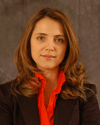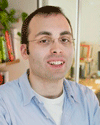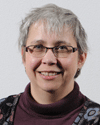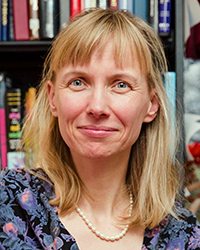Past CNS Talks

Abstract: The research and development activities of industries are extremely interconnected. We model the R&D decision of firms in industries as a function of their centrality in the network of firms. We also observe the impact on the optimal decisions of increasing the network dimension. Our work has clear policy implications on the funding of R&D a activities linked to the network characteristics (position, centrality) of the firms.
Bio: Filomena Garcia has joined Indiana University in 2011. Her research interests lie mainly in two areas:1) Game Theory and 2) Industrial organization. In game theory her focus is on noncooperative games with strategic complementarities and on the dynamics of network formation. In Industrial Organization, her current work focuses on the dynamic firm competition and on firm interaction in network industries. Professor Garcia has published in the Journal of Economic Theory, the Economic Letters, the International Journal of Industrial Organization, the Manchester School and, the Review of Network Economics. Prof. Garcia has obtained her PhD from CORE (Universite Catholique de Louvain) and her previous appointment was with the Technical University of Lisbon. She also belongs to the organizing committee of the Lisbon Meetings in Game Theory and Applications, an international conference held every year in Lisbon.

Nondestructive intervention for multi-agent systems
Jing Han
Abstract: This talk addresses the problem of how to coordinate Multi-Agent Systems (MASs) without destructing the original system. For a given multi-agent system where the local interaction rule of the already-existing agents can not be re-designed, one way to intervene the collective behavior of the system is to add one or a few special agents, called 'shills' into the group which are still treated as normal agents by the already-existing ones. Two case studies are presented: (1) how one intelligent shill leads a Vicsek-like MAS flocking model to reach consensus; (2) how a number of shills promote cooperation in a group of players that play finite end-unknown repeated Prisoner Dilemma.
Bio: I am born in Foshan, Canton. When I was in middle school, I was thrilled with computer algorithm and data structures, finally I co-authored a book Solving Problems by Searching and Programming (1993, Zhongshan University Press). This earned me the entrance to univesity without the National Entrance Exam. The change point in my career was in spring 1998, I decided to work on Complex Systems when I read the book Complexity. I got my Ph.D. in Computer Science in July 2002 from Department of Computer Science and Technology at the University of Science and Technology of China (USTC). My thesis was on Multi-agent algorithms to Combinatorial Optimization Problems. I was selected as the 2000-2002 international fellow of the Santa Fe Institute. I worked as a joint post-doc of Institute of Systems Science of Academy of Mathematics and Systems Science (AMSS) of Chinese Academy of Sciences (China) and the Santa Fe Institute (USA) from Aug. 2002 to June 2004. After that, I became faculty researcher of the Complex Systems Research Center in AMSS.
| 4:00 PM | Wells Library 001

CNS and IVL Open House
Faculty, Staff, and Students
Abstract: Open your laptops and demo your software. Bring posters to introduce your research questions and results. There will be presentations of research and demos of diverse tools between 4:15p - 5:45p.
Tools and Services (all slides)
—Online Interactive Maps, MapSustain, NRN
—Scholarly Database of 25 million scholarly records, http://sdb.cns.iu.edu
—VIVO National Researcher Network, http://vivo.cns.iu.edu
—Network Workbench Tool and Community Wiki, http://nwb.cns.iu.edu
—Science of Science Tool and Portal, http://sci2.cns.iu.edu
—Epidemics Tool and Marketplace, http://epic.cns.iu.edu

Abstract: Recent advances in network science have greatly increased our understanding of the structure and function of many networked systems, ranging from transportation networks, to social networks, the internet, ecosystems, and biochemical and gene transcription pathways. Network approaches are also increasingly applied to the brain, at several levels of scale from cells to entire brain systems. We now know that brain networks exhibit a number of characteristic topological features, including small-world attributes, modularity and hubs. I will review recent work on how complex brain networks are organized, and how their structural topology constrains and shapes their capacity to process and integrate information. I will place particular emphasis on the large-scale structure and neural dynamics of the human brain.
Bio: Olaf Sporns was born in Kiel, Germany, in 1963. After pursuing an undergraduate degree in Biochemistry at the University of Tübingen, he received a PhD in neuroscience from Rockefeller University (New York) in 1990. Following his PhD, he conducted postdoctoral work at The Neurosciences Institute in New York and San Diego. Currently he is a Provost Professor in the Department of Psychological and Brain Sciences at Indiana University in Bloomington, a member of the Graduate Programs in Cognitive Science and Neuroscience, and an Adjunct Professor in the School of Informatics and Computing. He received the Distinguished Faculty Award from Indiana University's College of Arts and Sciences in 2008 and a John Simon Guggenheim Memorial Fellowship in 2011. His book Networks of the Brain was published by MIT Press in 2011.

Abstract: Network models with preferential attachment, where new nodes are injected into the network and form links with existing nodes proportional to their current connectivity, have been well studied for some time. Extensions have been introduced where nodes attach proportional to arbitrary fitness functions. However, in these models attaching to a node increases the ability of that node to gain more links in the future. We study network growth where nodes attach proportional to the clustering coefficients, or local densities of triangles, of existing nodes. Attaching to a node typically lowers its clustering coefficient, in contrast to preferential attachment or rich-get-richer models. This simple modification naturally leads to a variety of rich phenomena, including non-poissonian bursty dynamics, community formation, aging and renewal. This shows that complex network structure can be modeled without artificially imposing multiple dynamical mechanisms.
Bio: James Bagrow joined Northwestern's Department of Engineering Sciences and Applied Mathematics in 2011. He is also a member of the Northwestern Institute on Complex Systems (NICO). Previously he was a postdoc in the Barabsi group at Northeastern University where he worked on social networks and human mobility. Dr. Bagrow received his PhD in physics in 2008 from Clarkson University. His research interests include complex networks, human dynamics, and statistical physics.
| 6:00 PM | Wells Library 001

Narcissism—Self Love and Knowledge Flows in Team Science
Andrea Scharnhorst
Abstract: NARCIS—the National Academic Research and Collaborations Information System—is the Dutch national
portal for information about researchers and their scholarly work. NARCIS consists of two databases: (1) An aggregation of the metadata of all open access publications and datasets within Dutch scholarly repositories and (2) the Dutch Research Information System with information about institutions, projects, and expertise of researchers employed at Dutch research institutions [1]. Using a dump of the NARCIS Dutch Research Information System made on April 3, 2012, we extracted the bi-partite network of 14 Dutch universities and their 8,156 full and assistant professors. Professors with only one affiliation appear in a dandelion pattern around their respective university, their multitude indicating the size of the university. The University of Amsterdam (Node 2) has 932 affiliated professors and is the largest university in The Netherlands. There are 265 professors with multiple university affiliations that interlink the Dutch universities to one national network also on the institutional level. Please be aware that through co-authorship and project collaboration the network between universities is much more intensive. This talk will also discuss alternative analyses of this dataset.
Bio: Andrea Scharnhorst is Head of Research at DANS and member of the e-humanities group at the Royal Netherlands Academy of Arts and Sciences in Amsterdam. Her work focuses on modelling and simulating the emergence of innovations (new modes of behaviour and learning, forms of communication, technologies or scientific ideas) in social systems. She has worked on transfer of concepts and methods at an interface between physics and social sciences and humanities. Currently, she coordinates the Computational Humanities Programme at the e-humanities group. She leads the working group “Information and Knowledge” of the COST action MP0801 “Physics of Competition and Conflicts”. Together with Andreas Pyka she edited a book on “Innovation networks” (2009), a special issue together with Katy Börner on “ Science of Science” in the Journal of Informetrics (2009), and another special issue on "Modeling science: studying the structure and dynamics of science" (together with Katy Börner, Wolfgang Glänzel and Peter van den Besselaar). Another book on "Models of Science Dynamics - Encounters Between Complexity Theory and Information Sciences (co-edited with Katy Börner and Peter van den Besselaar) appeared in 2012.
| 6:00 PM | Wells Library 001

Temporal Data Analysis: Burst detection and Evolving Networks using Sci2
Ted Polley
Abstract: This hands-on session introduces temporal data analysis. Specifically, we will demonstrate and discuss the utility of Kleinberg's burst detection algorithm and the design of evolving network visualizations.
Bio: Ted Polley is a Research Assistant at the Cyberinfrastructure for Network Science (CNS) Center. He recently obtained a dual Master’s degree in Library and Information Science from the School of Library and Information Science at Indiana University. He has extensive experience testing and documenting the information visualization software programs developed at CNS and serves as a professional contributor to research, performing software testing and documentation, and responding to user questions.

Growing Knowing Flowing: Evolving Ways to Collaborate on Complex Problems
Michael Beyerlein
Abstract: Genius is attributed to people who create new paradigms, new ways of seeing. Examples include Newton, Einstein, Picasso, Beethoven, and Pasteur. Teams bring together a group of people with knowledge, experience, and skill to tackle problems. Where are the genius teams? Creative knowledge work depends on sharing questions, ideas, and experiences. In the sharing process, knowledge flows from one person to another through a variety of channels that includes interpersonal communications, archived information such as books, and modern cyberinfrastructure. Each of these channels enhances or restricts flow in a variety of ways. Constructal theory suggests that the channels naturally evolve to handle more capacity and minimize resistance to flow. The more complex the problem, the more knowledge must be brought to bear, so flow becomes crucial. Project team creativity depends on flow capacity in each type of channel. That capacity approaches optimal levels only when complex structure has evolved in the team and fits the environment. With optimal flow, knowledge can grow, and perhaps team genius will emerge.
Bio: Michael Beyerlein is a Professor in the Technology Leadership & Innovation Department at Purdue University. Formerly, he was department head of Organizational Leadership & Supervision at Purdue and prior to that Founding Director of the Center for Collaborative Organizations and Professor of Industrial/Organizational Psychology at the University of North Texas. His research interests include: collaboration, including work teams, virtual teams, and virtual organizations; organizational design and change; and creativity and innovation. His current projects focus on the interplay of social and technical factors in virtual collaboration, team creativity, team curriculum for K-12, and innovation science. He was senior editor of the Elsevier annual series Advances in Interdisciplinary Studies of Work Teams and the Jossey-Bass/Pfeiffer series Collaborative Work Systems. He has published 50 journal articles and book chapters and edited or authored 20 books, including: The handbook for high performance virtual teams: A toolkit for collaborating across boundaries (2008). His funding has come from both the National Science Foundation and industry. He has been involved in projects with such companies as Boeing, Shell, NCH, AMD, Intel, Raytheon, First American Financial, Westinghouse, and Xerox and with government agencies such as Veterans Affairs, DCMAO, ARI, and EPA.

Network Visualization using Gephi
Ted Polley
Abstract: This hands-on session provides an introduction to a widely used network visualization tool.
Gephi Network Visualization Tool (Gephi)
Gephi is an interactive visualization and exploration platform for all kinds of networks and complex systems, dynamic and hierarchical graphs. Powered by its ad-hoc OpenGL engine, Gephi is pushing the envelope on how interactive and efficient network exploration can be, see also https://gephi.org/features:
— Networks up to 50,000 nodes and 1,000,000 edges
— Iterate through visualization using dynamic filtering
— Rich tools for meaningful graph manipulation
Runs on Windows, Linux and Mac OS X. Gephi is open-source and free.
Bio: Ted Polley is a Research Assistant at the Cyberinfrastructure for Network Science (CNS) Center. He recently obtained a dual Master’s degree in Library and Information Science from the School of Library and Information Science at Indiana University. He has extensive experience testing and documenting the information visualization software programs developed at CNS and serves as a professional contributor to research, performing software testing and documentation, and responding to user questions.

Drug Interaction Research: A Translational Bioinformatics Spectrum
Lang Li
Abstract: A translational bioinformatics spectrum will be introduced for the drug interaction research. We will describe computational biology and medical informatics approaches that can predict drug interaction signals from published literatures, electronic medical records, and public genomics databases. In addition, various molecular biology mechanisms are investigated for the drug interaction signals.
Bio: 1996-2001:Ph.D. in Biostatistics from The University of Michigan; 2001-now: Assistant and then Associate Professor in Medical and Molecular Genetics in IU School of Medicine; joint appointment in Biostatistics, Clinical Pharmacology, and IUPUI School of Informatics. 2009-now: Director of Bioinformatics Core, 2010-now: Associate Director of Center for Computational Biology and Bioinformatics, 2010-now: Associate Director of Indiana Institute of Personalized Medicine, 2009-now: Scientific Program Committee of the Society of Clinical Pharmacology and Therapeutics. Research interests: drug interaction and pharmacogenomics, literature based discovery, physiologically based kinetics models, bioinformatics, and statistics. Publications: 115 peer reviewed papers (50 first or senior authored papers) in journals from the research fields: clinical pharmacology, cancer research, bioinformatics, and statistics.

Network Analysis using the Network Workbench (NWB) and the Science of Science Tool (Sci2)
Ted Polley and Katy Börner
Abstract: This hands-on session provides an introduction to two tools:
Network Workbench Tool (NWB)
The NWB Tool supports researchers, educators, and practitioners interested in the study of biomedical, social and behavioral science, physics, and other networks.
Science of Science Tool (Sci2)
The Sci2 Tool was specifically developed for science policy makers and researchers that study science by scientific means. It supports the temporal, geospatial, topical, and network analysis and visualization of scholarly datasets at the micro (individual), meso (local), and macro (global) levels. There exists a continuously updated Sci2 Tool wiki and 24 hours of NIH tutorials in this tool.
Bio: Ted Polley is a Research Assistant at the Cyberinfrastructure for Network Science (CNS) Center. He recently obtained a dual Master’s degree in Library and Information Science from the School of Library and Information Science at Indiana University. He has extensive experience testing and documenting the information visualization software programs developed at CNS and serves as a professional contributor to research, performing software testing and documentation, and responding to user questions.
Katy Börner is the Victor H. Yngve Professor of Information Science at the School of Library and Information Science, Adjunct Professor at the School of Informatics and Computing, Adjunct Professor at the Department of Statistics in the College of Arts and Sciences, Core Faculty of Cognitive Science, Research Affiliate of the Biocomplexity Institute, Fellow of the Center for Research on Learning and Technology, Member of the Advanced Visualization Laboratory, and Founding Director of the Cyberinfrastructure for Network Science Center (http://cns.iu.edu) at Indiana University. She held Visiting Professor appointments at NIH (July 2010), Eidgenössische Technische Hochschule Zürich (ETH), Switzerland (June 2011), and the Royal Netherlands Academy of Arts and Sciences (KNAW), The Netherlands (2012). She is a curator of the Places & Spaces: Mapping Science exhibit (http://scimaps.org). Her research focuses on the development of data analysis and visualization techniques for information access, understanding, and management; particularly the study of the structure and evolution of scientific disciplines and the development of cyberinfrastructures for large scale scientific collaboration and computation. She holds a MS in Electrical Engineering from the University of Technology in Leipzig, 1991 and a Ph.D. in Computer Science from the University of Kaiserslautern, 1997.

Design and Update of a Classification System: The UCSD Map of Science
Katy Börner
Abstract: Global maps of science can be used as a reference system to chart career trajectories, the location of emerging research frontiers, or the expertise profiles of institutes or nations. This paper details data preparation, analysis, and layout performed when designing and subsequently updating the UCSD map of science and classification system. The original classification and map use 7.2 million papers and their references from Elsevier’s Scopus (about 15,000 source titles, 2001-2005) and Thomson Reuters’ Web of Science (WoS) Science, Social Science, Arts & Humanities Citation Indexes (about 9,000 source titles, 2001-2004)—about 16,000 unique source titles. The updated map and classification adds six years (2005-2010) of WoS data and three years (2006-2008) from Scopus to the existing category structure—increasing the number of source titles to about 25,000. To our knowledge, this is the first time that a widely used map of science was updated. A comparison of the original 5-year and the new 10-year maps and classification system show (i) an increase in the total number of journals that can be mapped by 9,409 journals (social sciences had a 80% increase, humanities a 119% increase, medical (32%) and natural science (74%)), (ii) a simplification of the map by assigning all but five highly interdisciplinary journals to exactly one discipline, (iii) a more even distribution of journals over the 554 subdisciplines and 13 disciplines when calculating the coefficient of variation, and (iv) a better reflection of journal clusters when compared with paper-level citation data. When evaluating the map with a listing of desirable features for maps of science, the updated map is shown to have higher mapping accuracy, easier understandability as fewer journals are multiply classified, and higher usability for the generation of data overlays, among others. Paper and data are at http://sci.cns.iu.edu/ucsdmap. This is collaborative work with Richard Klavans, Michael Patek, Angela M. Zoss, Joseph R. Biberstine, Robert P. Light, Vincent Lariviere, and Kevin W. Boyack.
Bio: Katy Börner is the Victor H. Yngve Professor of Information Science at the School of Library and Information Science, Adjunct Professor at the School of Informatics and Computing, Adjunct Professor at the Department of Statistics in the College of Arts and Sciences, Core Faculty of Cognitive Science, Research Affiliate of the Biocomplexity Institute, Fellow of the Center for Research on Learning and Technology, Member of the Advanced Visualization Laboratory, and Founding Director of the Cyberinfrastructure for Network Science Center (http://cns.iu.edu) at Indiana University. She held Visiting Professor appointments at NIH (July 2010), Eidgenössische Technische Hochschule Zürich (ETH), Switzerland (June 2011), and the Royal Netherlands Academy of Arts and Sciences (KNAW), The Netherlands (2012). She is a curator of the Places & Spaces: Mapping Science exhibit (http://scimaps.org). Her research focuses on the development of data analysis and visualization techniques for information access, understanding, and management; particularly the study of the structure and evolution of scientific disciplines and the development of cyberinfrastructures for large scale scientific collaboration and computation. She holds a MS in Electrical Engineering from the University of Technology in Leipzig, 1991 and a Ph.D. in Computer Science from the University of Kaiserslautern, 1997.





